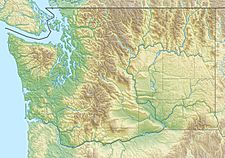Lynch Glacier facts for kids
Quick facts for kids Lynch Glacier |
|
|---|---|
| Type | Alpine glacier |
| Coordinates | 47°34′20″N 121°10′50″W / 47.57222°N 121.18056°W |
| Length | .60 mi (0.97 km) |
| Terminus | Icefall/proglacial lake |
| Status | Retreating |
Lynch Glacier is a fascinating ice formation found in the U.S. state of Washington. It lies near a tall mountain called Mount Daniel. A glacier is like a very slow-moving river of ice. Lynch Glacier is a special type called an alpine glacier, which means it forms in mountain valleys.
Contents
What is Lynch Glacier Like?
Lynch Glacier is about .60 mi (0.97 km) long. At its widest point, it stretches about .80 mi (1.29 km) across. This glacier starts high up in the mountains, at about 7,800 ft (2,400 m). It then flows downhill to about 6,400 ft (2,000 m).
Pea Soup Lake
At the lower end of the glacier, the ice stops above a lake. This lake is called Pea Soup Lake because of its greenish color. It's a proglacial lake, which means it was formed by the glacier itself.
Glacier's Shape
A rocky ridge, known as an arête, divides Lynch Glacier. This ridge splits the glacier into two parts: an eastern side and a western side. The western part of the glacier is larger than the eastern part.
Where is Lynch Glacier Located?
Lynch Glacier is located in a beautiful natural area. It is part of the Alpine Lakes Wilderness. This wilderness area is found within the Snoqualmie National Forest. Both of these places are in King County, Washington. It's a wild and protected area where nature thrives.
How Glaciers Change Over Time
Glaciers are not always the same size. They can grow or shrink over many years. This change is often due to how much snow falls and how warm the weather is. When a glacier gets smaller, it is called "retreating."
Lynch Glacier's Retreat
Lynch Glacier has been retreating over time. In the late 1970s, the ice of Lynch Glacier actually reached into Pea Soup Lake. But pictures taken more recently show that the glacier has pulled back. Now, it no longer touches the lake. This shows how glaciers can change and move over decades.


